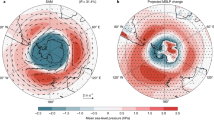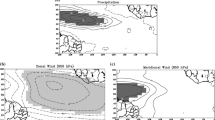Summary
Intraseasonal variation of tropical convergence zones (TCZ) is studied focussing on the three major features of the TCZ over the Indian longitudes during the summer monsoon viz. (i) the oscillation between active and weak spells, (ii) the occurrence of two favourable zones — one over the equatorial oceans and another over the heated continent and (iii) poleward propagations of the oceanic TCZ onto the heated continent. An observational study of the intraseasonal variation over different parts of the tropics has shown that the first feature may be an ubiquitous feature of the TCZ variations, the second occurs only over the Asian summer and winter monsoon zones, and the third only over the Asian summer monsoon. Analysis of a simple monsoon model has revealed that poleward propagation occurs in the presence of a meridional surface temperature gradient because the convective heating is asymmetric, with more heating on the poleward side. Preliminary analysis of the T-21 version of the ECMWF model has shown that it is capable of simulating the three major features of the intraseasonal variation of the TCZ over the Indian longitudes during the summer monsoon.
Similar content being viewed by others
References
Ananthakrishnan, R., 1987: Personal communication.
Anthes, A. R., 1977: A cumulus parameterization scheme utilizing a one-dimensional cloud model.Mon. Wea. Rev.,105, 270–286.
Fischer, G., 1987: Climate simulations with the ECMWF T21-Model in Hamburg Large scale atmospheric modelling. Report 1, Meteorologisches Institut der Universität Hamburg.
Gadgil, S., 1988: Recent advances in monsoon research with particular reference to the Indian monsoon.Aust. Met. Mag.,36, 193–204.
Gadgil, S., Guruprasad, A., 1989: An objective method for the identification of the intertropical convergence zone.J. Climat. (submitted).
Gadgil, S., Joseph, P. V., Joshi, N. V., 1984: Ocean-atmosphere coupling over monsoon regions.Nature,312, 141–143.
Goswami, B. N., Shukla, J., 1984: Quasi-periodic oscillations in a symmetric general circulation model.J. Atmos. Sci.,41, 20–37.
Graham, N. E., Barnett, T. P., 1987: Sea surface temperature, surface wind divergence and convection over tropical oceans.Science,238, 657–659.
Gray, W. M., 1968: Global view of the origin of tropical disturbances and storms.Mon. Wea. Rev.,96, 669–700.
Hahn, D. G., Manabe, S., 1975: The role of mountains in the south Asian monsoon circulation.J. Atmos. Sci.,32, 1515–1541.
Hansen, J., Russell, G., Rind, D., Stone, P., Lacis, A., Lebedeff, S., Ruedy, R., Travis, L., 1983: Efficient three-dimensional global models for climate studies: Models I and II.Mon. Wea. Rev.,111, 609–661.
Hastenrath, S., Lamb, P., 1979:Climatic Atlas of Indian Ocean, Part I. Univ. Wisconsin Press.
Hayashi, Y., Golder, D. G., 1986: Tropical intraseasonal oscillations in a GFDL general circulation model and FGGE data. Part 1: Phase propagations.J. Atmos. Sci.,43, 3058–3067.
Joseph. P. V., 1988: Variability of tropical Indian and Pacific Oceans in relation to the Indian summer monsoon. Proc., Workshop on Tropical Ocean-Atmosphere Variability. Indian Inst. Sci., February 1987, pp. 34–48.
Kiladis, G., 1988: Some comments on the model's precipitation climatology. In:Climate Simulating with the ECMWF T21 Model in Hamburg, Part II: Climatology and Sensitivity Experiments (Storch, H. V., ed.).
Krishnamurti, T. N., 1979:Compendium of Meteorology, Vol. II, Part 4. W.M.O.
Krishnamurti, T. N., Bhalme, H. N., 1976: Oscillations of a monsoon system. Part 1. Observational aspects.J. Atmos. Sci.,33, 1937–1954
Lau, N.-C., 1981: A diagnostic study of recurrent meteorological anomalies appearing in a 15-year simulation with a GFDL general circulation model.Mon. Wea. Rev.,109, 2287–2311.
Lau, K. M., Chan, P. H., 1986: Aspects of the 40–50 day oscillation during northern summer as inferred from OLR.Mon. Wea. Rev.,114, 1354–1367.
Madden, R. D., Julian, P., 1971: Detection of a 40–50 day oscillation in the zonal wind in the tropical Pacific.J. Atmos. Sci.,28, 702–708.
Mooley, D. A., Shukla, J., 1987: Variability and forecasting of the summer monsoon rainfall over India. In: Chang, C.-P., Krishnamurti, T. N. (eds.):Oxford Monographs on Geology and Geophysics, No. 7.
Murakami, T., 1976: Cloudiness fluctuations during the summer monsoon.J. Meteor. Soc. Japan,54, 175–181.
Ooyama, K., 1969: Numerical simulation of the life cycle of tropical cyclones.J. Atmos. Sci.,26, 3–40.
Parthasarathy, B., Munot, A. A., Kothawale, D. R., 1988: Regression model for estimation of Indian foodgrain production from summer monsoon rainfall.Agric. and Forest Meteor.,42, 167–182.
Ramamurthy, K., 1969: Some aspects of the break in the Indian southwest monsoon during July and August.Forecasting Manual. 1–57, 18.3, India Met. Dept., Poona, India
Rasmusson, E. M., Carpenter, T. H., 1982: Variations in tropical sea surface temperature and surface wind fields associated with the souther oscillation/El Nino.Mon. Wea. Rev.,110, 354–384.
Rao, Y. P., 1976: Southwest monsoon. India Meteorological Department, Meteorological Monograph, Synoptic Meteorology No. 1/1976, Delhi, 367 pp.
Sikka, D. R., 1980: Some aspects of the large-scale fluctuations of summer monsoon rainfall over India in relation to fluctuations in the planetary and regional circulation parameters.Proc. Indian Acad. Sci. (Earth and Planetary Sci.),89, 179–195.
Sikka, D. R., Gadgil, S., 1980: On the maximum cloud zone and the ITCZ over India longitude during the southwest monsoon.Mon. Wea. Rev.,108, 1840–1853.
Webster, P. J., 1983: Mechanisms of monsoon low frequency variability: surface hydrological effects.J. Atmos. Sci.,40, 2110–2127.
Webster, P. J., Chou, L. C., 1980a: Seasonal structure of a simple monsoon system.J. Atmos. Sci.,37, 354–367.
Webster, P. J., Chou, L. C.: 1980b: Low-frequency transitions of a simple monsoon system.J. Atmos. Sci.,37, 368–382.
Webster, P. J., Lau, K. M., 1977: A simple ocean-atmosphere climate model: Basic model and a simple experiment.J. Atmos. Sci.,34, 1063–1084.
Yasunari, T., 1979: Cloudiness fluctuations associated with the northern hemisphere summer monsoon.J. Met. Soc. Japan,57, 227–242.
Yasunari, T., 1980: Quasi-stationary appearance of 30–40 day period in the cloudiness fluctuations during summer monsoon over India.J. Met. Soc. Japan,58, 225–229.
Yasunari, T., 1981: Structure of an Indian summer monsoon system with around 40-day period.J. Met. Soc. Japan,59, 336–354.
Yoo, J.-M., Carlton, J. A., 1988: Spatial dependence of the relationship between rainfall and outgoing longwave radiation in the tropical Atlantic.J. Climat.,1, 1047–1054.
Author information
Authors and Affiliations
Additional information
With 16 Figures
Rights and permissions
About this article
Cite this article
Gadgil, S., Srinivasan, J. Low frequency variation of tropical convergence zones. Meteorl. Atmos. Phys. 44, 119–132 (1990). https://doi.org/10.1007/BF01026814
Received:
Revised:
Issue Date:
DOI: https://doi.org/10.1007/BF01026814




